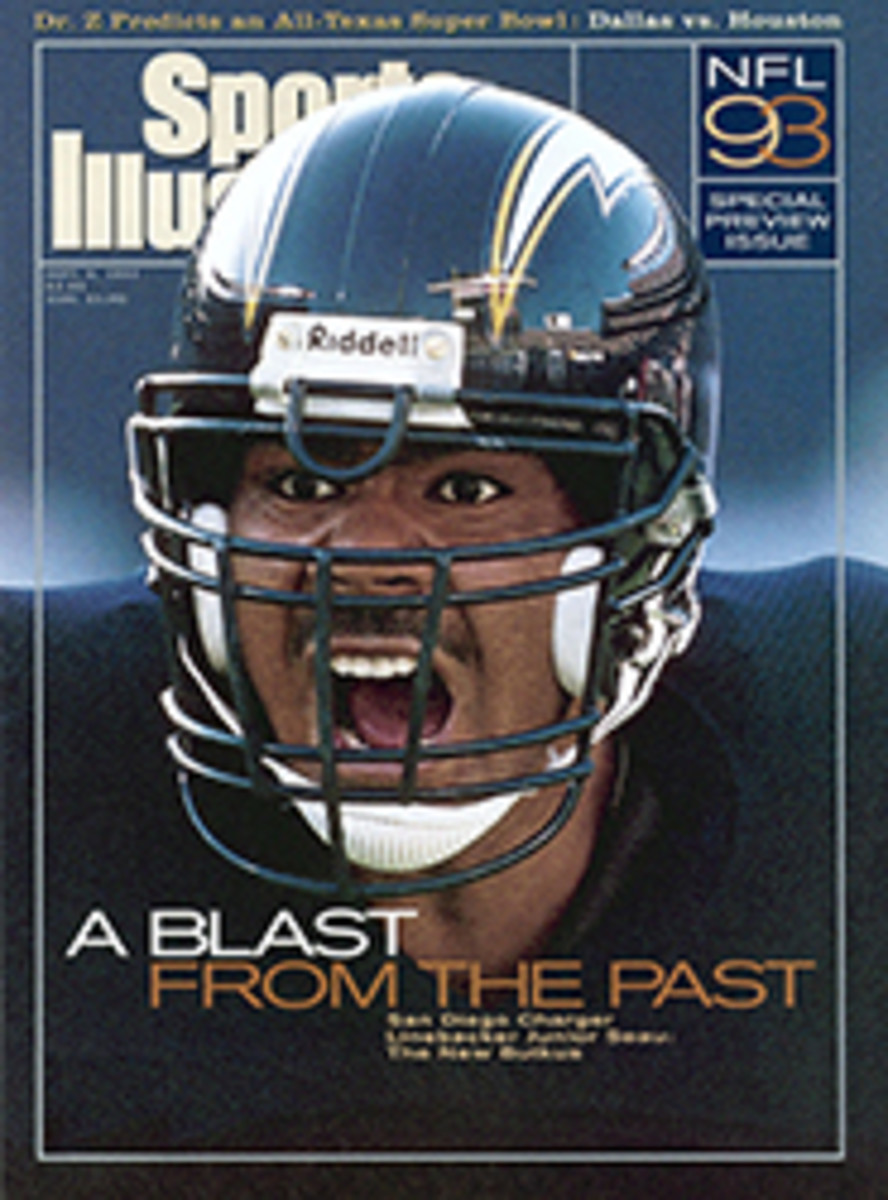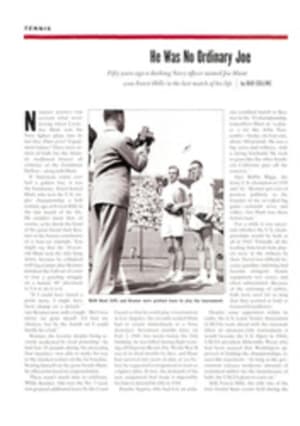
THE BIGGEST COWBOY
In the film room of the Chicago Bears this past spring the team's new offensive line coach, Tony Wise, who had spent the four previous seasons building the Dallas Cowboys' line, was teaching his new Bear charges their blocking schemes. On the screen Dallas right tackle Erik Williams fired off the line and began to drive-block Los Angeles Raider defensive end Greg Townsend. It was the sort of block that offensive linemen dream of and defensive linemen get cut for—if it happens too often. Williams drove Townsend back until Townsend was supine in the end zone and Emmitt Smith had scored on a four-yard run in Williams's wake. "Hey, Tony," a Bear piped up in the film room, "that guy Williams is pretty good."
Sitting in his office in Dallas, Cowboy coach Jimmy Johnson recalls the play. "I know the block," he says as he rises from his chair to demonstrate. Johnson shoots his arms out quickly, three times. "Erik gets into him at the line, bam bam bam, and gets him going backwards until"—Johnson sits back down, thrusting his feet in the air—"his feet are like this. And there's a hole where Townsend used to be, as wide as this desk."
Townsend, a small but fiery end with 100 sacks in his 10-year career, likes to play mental games with opponents. On the play before the Smith touchdown, he had sought to intimidate Williams, a monstrous pup of a right tackle. "You're not going to put me on my back." Townsend told Williams. What followed was a defining moment for Williams.
As he enters his third NFL season, the 25-year-old Williams has outplayed every offensive lineman drafted in the '90s, with the exception of Miami Dolphin tackle Richmond Webb. The sixth offensive tackle drafted in '91, Williams is the Cowboys' most indispensable lineman and, at 6'6" and 321 pounds, their biggest. Growing up two miles from Veterans Stadium in southwest Philadelphia, he was always too big for the weight limits of youth league football. So he would organize pickup games on his street and play eight-on-eight with kids from other neighborhoods. The games would start out as "rough touch," in which players had to be touched hard with two hands to be down. But they inevitably wound up as full-blown tackle. On the street. With cars parked on one side.
Williams became a dominant defensive lineman in high school, but the NFL was only a distant dream. Poor grades prevented him from landing a major-college scholarship, so he enrolled at tiny Central State in Wilberforce, Ohio, an NAIA school. Williams became a star, but pro scouts were skeptical about the level of competition he had faced and about the school's lack of sophisticated strength training.
When Wise visited Central State to look over Williams, he had the same reservations, but he loved one thing about Williams—his toughness. "Nothing wrong with a head slap, a head butt or an extra hit after the play," Williams says. "You've got to establish yourself as the boss out there."
Dallas has made some wonderful trades since Jerry Jones bought the team in 1989. But next to unloading Herschel Walker for five players and a passel of draft picks, the Cowboys' best move is one they failed to make. On draft day in '91 they tried to trade the 12th and the 14th picks in the first round to the Tampa Bay Buccaneers, who had the seventh choice, to get Tennessee tackle Charles McRae. But Tampa Bay said no. So Dallas took wide receiver Alvin Harper with pick No. 12; traded down three times with the 14th pick to acquire second-, third-, fourth- and fifth-round selections; and chose Williams in the third round.
"Oh, god, don't remind me," says Wise now. "I wanted McRae." McRae has been a disappointment for the Bucs. Instead of getting the first offensive lineman in the draft, Dallas got the 10th. "Put it this way," Johnson says, sounding the tiniest bit smug, "I wouldn't trade Erik for any of them right now."
Williams starred in a few training-camp scuffles as a rookie, but his first start was a disaster. In the Cowboys' ninth game of the '91 season, Johnson put Williams at left tackle because of injuries to Mark Tuinei, and Phoenix Cardinal linebacker Ken Harvey chewed him up with three first-half sacks. Williams steadily improved, though, and Dallas moved him to the right side in '92.
Some Cowboy observers viewed that move as a sign of the team's uncertainty about Williams because left tackle is traditionally the more demanding position. Last season, however, the NFC East featured three left defensive ends—Reggie White of the Philadelphia Eagles, Charles Mann of the Washington Redskins and Eric Dorsey of the New York Giants—who were better than most of the division's right ends. "In any other division, you worship left tackles," says Johnson. "Here, the right tackle's just as important."
Williams might eventually have to go to the left side to prove himself as one of the game's premier players. For now, though, why move? Williams proved his worth last season in three games against White, his old Philadelphia idol. Williams is a shy, modest fellow, and over a lunch in Dallas, the only time he strings together a few sentences is when the conversation turns to White.
"The day in training camp they named me the starter at right tackle, my first thought was, I gotta get ready for Reggie," says Williams. "We weren't playing them till October, but even early in the season, I watched extra film of him. I was edgy. Put yourself in my shoes. I'm from Philadelphia, I watched Reggie growing up, and I wanted to be like him. Now my job is to block him for a team in the NFL. I mean, that was big, man."
White had two sacks in their first meeting, a 31-7 Eagle win. White had no sacks and only three tackles in the second meeting. That game, a 20-10 Dallas victory, earned Williams the conference's Offensive Player of the Week award. He was the only lineman to win it all season. Williams handled White even more effectively in their third meeting, in the NFC playoffs on Jan. 10.
Dallas's strategy for containing White was to close down the inside path and make him take a wide rush by pushing him outside, where Williams's quick feet would enable him to stay with White. "Make him go the long way, play after play," says Wise, "and frustration will set in."
In Dallas's 34-10 win, Williams blocked White one-on-one on 39 of Dallas's 65 offensive plays. In the second quarter White beat Williams cleanly for a sack of quarterback Troy Aikman, and then he beat Williams around end and pushed Aikman as he threw. But the final tally was all Williams: On 32 plays in which he faced White one-on-one, White never touched the man with the ball. Says Williams, "After the game, I thought, Boy, I can play in this league."
For a quiet guy, he just said it all.
PHOTO
JERRY LODRIGUSS
Always too big for youth leagues, Williams (79) learned football the hard way—on Philly's mean streets.
PHOTO
LARRY LAMBRECHT
[See caption above.]

